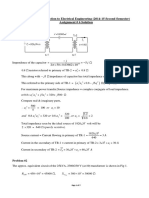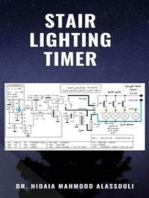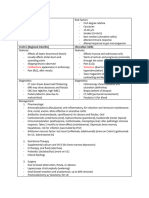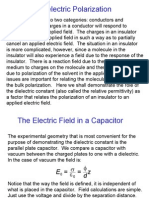Electrical Power Systems Wadhwa 8
Electrical Power Systems Wadhwa 8
Uploaded by
ragupaCopyright:
Available Formats
Electrical Power Systems Wadhwa 8
Electrical Power Systems Wadhwa 8
Uploaded by
ragupaOriginal Description:
Copyright
Available Formats
Share this document
Did you find this document useful?
Is this content inappropriate?
Copyright:
Available Formats
Electrical Power Systems Wadhwa 8
Electrical Power Systems Wadhwa 8
Uploaded by
ragupaCopyright:
Available Formats
PERFORMANCE OF LINES 67
1
Now resistance of copper conductor at 20C is per metre length when the section is
58
1 mm2.
1 20 1000
Resistance = = 3.83 ohm
58 90
10 1000
The current = = 218.68 amps
3 33 0.8
Since the capacitance is to be neglected, the receiving end current is same as the sending
end and, therefore,
the loss on the line = 3 218.682 3.83 = 0.549 MW
output 10
= = = 0.9479
output + loss 10 + 0.549
To determine the voltage regulation we determine the sending end voltage
Vs = (Vr cos r + IrR) + j(Vr sin r + IrX)
= (19052 0.8 + 218.68 3.83) + j(19052 0.6 + 218.68 6.65)
= 16079 + j12885
Vs = 20605 volts
Since it is a short line, the voltage regulation will be
20605 19052
% regulation = 100 = 8.15%. Ans.
19052
Example 4.4: A 400 V, 3-phase 4-wire service mains supplies a star connected load. The
resistance of each line is 0.1 ohm and that of neutral 0.2 ohm. The load impedances are ZR
= (6 + j9), ZY = 8 ohms and ZB = (6 j8). Calculate the voltage across each load impedance and
current in the neutral. Phase sequence RYB.
Solution: Since it is a 3-phase, 4-wire system, the current in each line can be found out
considering each phase independent of each other and then we add all the three currents to
find out the current in the neutral.
Taking phase R as reference,
400 + j0.0
IR =
3 (6.3 + j 9.0)
231(6.3 j 9.0)
= = 12.06 j17.22
120.69
231 120
IY = = 27.83( 0.5 j0.866)
8.3
= 13.92 j24.1
231 120 231(6.3 + j 8) 120
IB = = = 2.23(6.3 + j8) 120
(6.3 j 8) 103.69
= (14.05 + j17.84) ( 0.5 + j0.866) = 22.47 + j3.24
You might also like
- SolEx01 2019Document7 pagesSolEx01 2019sibtainNo ratings yet
- Impedance Correction FactorDocument7 pagesImpedance Correction FactorEngr Fahimuddin QureshiNo ratings yet
- Problemas Resueltos Cortocircuitos Asimetricos PDFDocument10 pagesProblemas Resueltos Cortocircuitos Asimetricos PDFbrunoNo ratings yet
- 5.1. A 69-kV, Three-Phase Short Transmission Line Is 16 KM Long. The Line HasDocument16 pages5.1. A 69-kV, Three-Phase Short Transmission Line Is 16 KM Long. The Line Hasمحمد عبد الوهابNo ratings yet
- Tutorial4 SolutionDocument6 pagesTutorial4 SolutionNikhil Kumar JaiswalNo ratings yet
- UsefulSolutions T&DDocument7 pagesUsefulSolutions T&Dkobamelo LetowaNo ratings yet
- SyncroDocument5 pagesSyncroRajat MittalNo ratings yet
- Solution of Tutorial Sheet-3 (Three Phase Networks) : Ans. Given, - Vab - 45kV, ZL (0.5 + j3), Z (4.5 + j9)Document10 pagesSolution of Tutorial Sheet-3 (Three Phase Networks) : Ans. Given, - Vab - 45kV, ZL (0.5 + j3), Z (4.5 + j9)Shroyon100% (2)
- Epillar 7sa DistanceDocument17 pagesEpillar 7sa DistancePandrayar MaruthuNo ratings yet
- Unit-5 Question Bank: Pole Arc 0.64 Pole PitchDocument15 pagesUnit-5 Question Bank: Pole Arc 0.64 Pole Pitchblaze emberNo ratings yet
- 5.11 (A) The Series Impedance Per Phase: Z R JLL J JDocument1 page5.11 (A) The Series Impedance Per Phase: Z R JLL J Jbi nohoNo ratings yet
- Interupting Current CalculationDocument4 pagesInterupting Current CalculationvisanuNo ratings yet
- Electric Power Transmission and Distribution System Engineering 2 RBCDocument17 pagesElectric Power Transmission and Distribution System Engineering 2 RBCeuler leoNo ratings yet
- 04 1200 261 C X Lat Hdpe 132 KV IV DuctbankDocument4 pages04 1200 261 C X Lat Hdpe 132 KV IV Ductbankengmostafa darwishNo ratings yet
- 3-Phase Short-Circuit Current (Isc) at Any Point Within A LV InstallationDocument8 pages3-Phase Short-Circuit Current (Isc) at Any Point Within A LV InstallationdhruvNo ratings yet
- ExercisesDocument5 pagesExerciseshus khNo ratings yet
- Assignment 3Document21 pagesAssignment 3whatsapp status worldNo ratings yet
- 2.8 Calculation and Load Schedule 2.8.1 Calculation: MM AT 7.6 AT 30.9Document4 pages2.8 Calculation and Load Schedule 2.8.1 Calculation: MM AT 7.6 AT 30.9PatcharapanPunjadNo ratings yet
- Power Engineering Questions and SolutionDocument7 pagesPower Engineering Questions and SolutionMoz Asik0% (1)
- 3ph Isc at LV InstallationDocument7 pages3ph Isc at LV InstallationbambangNo ratings yet
- PROBLEMS - Short Circuit 2Document7 pagesPROBLEMS - Short Circuit 2dbharanidharan_in6351No ratings yet
- ELEC-E8427-transmission Lines Home Exercise With SolutionDocument4 pagesELEC-E8427-transmission Lines Home Exercise With SolutionOskari OllilaNo ratings yet
- Franti EffectsDocument5 pagesFranti Effectsneha.sharma.jpr2786No ratings yet
- Chapter 4 SlidesDocument36 pagesChapter 4 Slidesmekonen100% (2)
- Single and Three - 2Document28 pagesSingle and Three - 2Rafiq_HasanNo ratings yet
- Problem Set 2Document4 pagesProblem Set 2Vipasha MittalNo ratings yet
- Synchronous CondenserDocument3 pagesSynchronous Condensersammykhaemba02No ratings yet
- Power System ProblemDocument10 pagesPower System ProblemDanylle Lajera DiazNo ratings yet
- ESO 203A: Introduction To Electrical Engineering (2014-15 Second Semester) Assignment # 6 SolutionDocument7 pagesESO 203A: Introduction To Electrical Engineering (2014-15 Second Semester) Assignment # 6 SolutionTejasv RajputNo ratings yet
- HW4 SolDocument4 pagesHW4 SolIsmael Khalil100% (1)
- Transmission Lines PDFDocument11 pagesTransmission Lines PDFsadNo ratings yet
- Mohit Jetani 1270404 0Document32 pagesMohit Jetani 1270404 0ronajoj120No ratings yet
- Model Answer For Second Mid TermDocument14 pagesModel Answer For Second Mid TermFrank HayagNo ratings yet
- Model Answer For Second Mid TermDocument14 pagesModel Answer For Second Mid TermFrank HayagNo ratings yet
- Experiment No. 1: PROBLEM STATEMENT: Design A Transmission Line of 70MW at 160KmDocument3 pagesExperiment No. 1: PROBLEM STATEMENT: Design A Transmission Line of 70MW at 160KmSanjeev RaiNo ratings yet
- Lecture 9 - Rev 00 - Jan 2018 - Line Feeder ProtDocument33 pagesLecture 9 - Rev 00 - Jan 2018 - Line Feeder ProtAbdallah LotfyNo ratings yet
- Medium Length Line ExampleDocument2 pagesMedium Length Line ExamplepecworldNo ratings yet
- Find The Thevenin Equivalent Circuit at A&b TerminalDocument4 pagesFind The Thevenin Equivalent Circuit at A&b TerminalHasibNo ratings yet
- Electric Power TransmissionDocument6 pagesElectric Power TransmissionLimuel John Vera CruzNo ratings yet
- KLM S1 Phys PP2 MSDocument7 pagesKLM S1 Phys PP2 MS25850338naomiNo ratings yet
- ELG3311P223Document5 pagesELG3311P223Imran HossainNo ratings yet
- Annex B (Informative) Sample Calculations: B.1 Square Grid Without Ground Rods-Example 1Document17 pagesAnnex B (Informative) Sample Calculations: B.1 Square Grid Without Ground Rods-Example 1Jeferson FranciscoNo ratings yet
- TSWF - 900.2 - Earthing Calculation For 110kV OHTL - Rev2Document4 pagesTSWF - 900.2 - Earthing Calculation For 110kV OHTL - Rev2Shinekhuu99No ratings yet
- Distance Protection - Eercise 1 - MemoDocument7 pagesDistance Protection - Eercise 1 - Memomoses kakwenaNo ratings yet
- Universitimalaysiaperlis: Emj32004 Power Systemengineering Laboratory Module2Document8 pagesUniversitimalaysiaperlis: Emj32004 Power Systemengineering Laboratory Module2ALINo ratings yet
- EEL303: Power Engineering I - Tutorial 5Document7 pagesEEL303: Power Engineering I - Tutorial 5Boora AasishNo ratings yet
- Anna University Solved Problems - UNIT 2Document9 pagesAnna University Solved Problems - UNIT 2RITHIK SAVIO G 21ECNo ratings yet
- Overhead Line Electrical CharacteristicsDocument2 pagesOverhead Line Electrical CharacteristicspecampbeNo ratings yet
- Transmission LinesDocument5 pagesTransmission LinesMark AginaNo ratings yet
- PHY 2042 Experiment #7Document3 pagesPHY 2042 Experiment #7Kelsey WNo ratings yet
- Electric Circuits Sample Problems and AnswersDocument5 pagesElectric Circuits Sample Problems and AnswerskakiksNo ratings yet
- Transform Sheet SolutionDocument16 pagesTransform Sheet SolutionSanjaya Srinath0% (1)
- Tugas1 AST - Triananda ZPDocument7 pagesTugas1 AST - Triananda ZP062002204024No ratings yet
- Lecture: Ir. M. Zaenal Efendi, MT.: Electronic Engineering Polythechnic Institute of SurabayaDocument19 pagesLecture: Ir. M. Zaenal Efendi, MT.: Electronic Engineering Polythechnic Institute of SurabayaApry PermatasariNo ratings yet
- Exercises in Electronics: Operational Amplifier CircuitsFrom EverandExercises in Electronics: Operational Amplifier CircuitsRating: 3 out of 5 stars3/5 (1)
- Analog Dialogue, Volume 48, Number 1: Analog Dialogue, #13From EverandAnalog Dialogue, Volume 48, Number 1: Analog Dialogue, #13Rating: 4 out of 5 stars4/5 (1)
- Electricity in Fish Research and Management: Theory and PracticeFrom EverandElectricity in Fish Research and Management: Theory and PracticeNo ratings yet
- Negative Sequence Transformation: W1 W2 W3 W4 W5 W6Document1 pageNegative Sequence Transformation: W1 W2 W3 W4 W5 W6ragupaNo ratings yet
- 14.12 Protection of Transformers: Protective RelaysDocument1 page14.12 Protection of Transformers: Protective RelaysragupaNo ratings yet
- Extracted Pages From Electrical - UG Core Course SyllabiDocument1 pageExtracted Pages From Electrical - UG Core Course SyllabiragupaNo ratings yet
- Ug Table 2017Document2 pagesUg Table 2017ragupaNo ratings yet
- Automatic Bathroom Light With Back-Up Lamp - Full Project AvailableDocument2 pagesAutomatic Bathroom Light With Back-Up Lamp - Full Project AvailableragupaNo ratings yet
- 1Document1 page1ragupaNo ratings yet
- Electrical Power Systems Wadhwa 15Document1 pageElectrical Power Systems Wadhwa 15ragupaNo ratings yet
- Electrical Power Systems Wadhwa 16Document1 pageElectrical Power Systems Wadhwa 16ragupaNo ratings yet
- Electrical Power Systems Wadhwa 13Document1 pageElectrical Power Systems Wadhwa 13ragupaNo ratings yet
- Electrical Power Systems Wadhwa 6Document1 pageElectrical Power Systems Wadhwa 6ragupaNo ratings yet
- Electrical Power Systems Wadhwa 12Document1 pageElectrical Power Systems Wadhwa 12ragupaNo ratings yet
- Electrical Power Systems Wadhwa 3Document1 pageElectrical Power Systems Wadhwa 3ragupaNo ratings yet
- 2Document1 page2ragupaNo ratings yet
- 2Document1 page2ragupaNo ratings yet
- Electrical Power Systems Wadhwa 6Document1 pageElectrical Power Systems Wadhwa 6ragupaNo ratings yet
- Electrical Power Systems Wadhwa 9Document1 pageElectrical Power Systems Wadhwa 9ragupaNo ratings yet
- F HG I KJ: Performance of LinesDocument1 pageF HG I KJ: Performance of LinesragupaNo ratings yet
- Performance of Lines: Definition: by Performance of Lines Is Meant The Determination of Efficiency and Regulation ofDocument1 pagePerformance of Lines: Definition: by Performance of Lines Is Meant The Determination of Efficiency and Regulation ofragupaNo ratings yet
- Temp Theory of Computation Assign 2Document22 pagesTemp Theory of Computation Assign 2Wolf shadowNo ratings yet
- Practical Research 1 - Q 1 - Mod 2 - Qualitative Research and Its Importance To Daily Life - v5Document33 pagesPractical Research 1 - Q 1 - Mod 2 - Qualitative Research and Its Importance To Daily Life - v5Fabio Jr CapitoNo ratings yet
- Hitachi Unified Storage Getting Started Guide PDFDocument92 pagesHitachi Unified Storage Getting Started Guide PDFquynhto89No ratings yet
- Jadual Masa Bersemuka Teori Dan Amali Ee-320-3:2012Document4 pagesJadual Masa Bersemuka Teori Dan Amali Ee-320-3:2012Siva 93No ratings yet
- Rajat Kapoor Assignment No. 3 8102Document4 pagesRajat Kapoor Assignment No. 3 8102kapoorrajat859500No ratings yet
- Week 3Document4 pagesWeek 3Ann Margaret Dela FuenteNo ratings yet
- Ganga River PollutionDocument8 pagesGanga River PollutionDr. Nitish Priyadarshi75% (4)
- Module 1 - EwDocument43 pagesModule 1 - EwMurtaza Hassan Bhat100% (1)
- DEUTZ PowerSolutions PDFDocument9 pagesDEUTZ PowerSolutions PDFAli ButtNo ratings yet
- Ejercicios de Programación 03Document5 pagesEjercicios de Programación 03Angel Huillca HuallpaNo ratings yet
- The FlyDocument10 pagesThe Flyআমার আমি0% (1)
- Maxseal Solenoid ValveDocument4 pagesMaxseal Solenoid ValvesallehasanNo ratings yet
- Asm Full CombinedDocument294 pagesAsm Full CombinedItachi UchihaNo ratings yet
- Partial Fractions Examinations 3B SolutionDocument2 pagesPartial Fractions Examinations 3B SolutionAYOMIDE GODWINNo ratings yet
- Rapid P0022 Punj CVS DWG 5100 0095 - 1Document1 pageRapid P0022 Punj CVS DWG 5100 0095 - 1testNo ratings yet
- Ibadan - Nigeria - Reconnaissance - Visit - KopieDocument10 pagesIbadan - Nigeria - Reconnaissance - Visit - KopieAgung BudiantoNo ratings yet
- GASTROINTESTINALDocument9 pagesGASTROINTESTINALjsreyes.402No ratings yet
- CH-2 MasonryDocument24 pagesCH-2 MasonryEyoatem TeferiNo ratings yet
- Appearance and Service of Complete DishesDocument6 pagesAppearance and Service of Complete DishesVansh KaliaNo ratings yet
- Granadeiro Et Al. - 2018 - Efficient Oxidative Desulfurization Processes Using Polyoxomolybdate Based CatalystsDocument11 pagesGranadeiro Et Al. - 2018 - Efficient Oxidative Desulfurization Processes Using Polyoxomolybdate Based CatalystsJuan Díaz SantibáñezNo ratings yet
- B Maxx 5500: EnglishDocument316 pagesB Maxx 5500: EnglishYiliang ChenNo ratings yet
- Part 2. Causes of DiseasesDocument12 pagesPart 2. Causes of DiseasesKakuru Joseph mNo ratings yet
- HSCCatalog Vickers1Document1,396 pagesHSCCatalog Vickers1Roberto Carlos Carrizo100% (2)
- Datashieet Integrat Calc Electr Centrala Audi SMD Marcaj WCs bcr133 - I PDFDocument17 pagesDatashieet Integrat Calc Electr Centrala Audi SMD Marcaj WCs bcr133 - I PDFDan IvanNo ratings yet
- Dielectric PolarizationDocument28 pagesDielectric PolarizationMuhammad FarooqNo ratings yet
- UGRD-CPE6300A Digital Electronics 2 ThreeDocument8 pagesUGRD-CPE6300A Digital Electronics 2 ThreeMER HANNo ratings yet
- 2.4 Electric CircuitsDocument18 pages2.4 Electric CircuitsRheina VelasquezNo ratings yet
- Catalogue 2015: New "Flexilux"Document105 pagesCatalogue 2015: New "Flexilux"TBS Máy Phát ĐiệnNo ratings yet
- Bursa Malaysia Sector ClassificationsDocument1 pageBursa Malaysia Sector ClassificationsNeo4u4433% (3)
- AGE FinalDocument19 pagesAGE FinalShravya SridharNo ratings yet











































































































